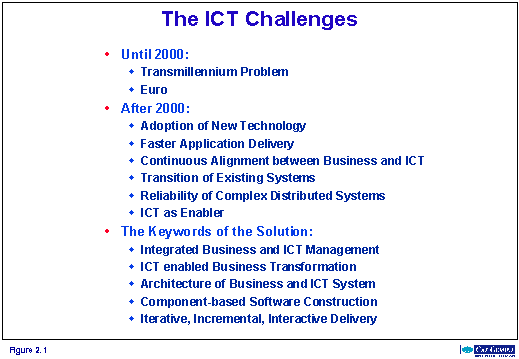Outline of ProgrammeX
| 2. The ICT Challenges |
The most important current technology trend is the integration of information technology and communication technology. This integrated information and communication technology (ICT) means new challenges for both the suppliers and the users of ICT.

Until the year 2000 the main challenges for the ICT industry and the users of ICT are the transmillennium problem and the introduction of the Euro. These challenges leave little room for investment in other ICT developments.
After the year 2000 the ICT industry and its customers will be confronted with the challenges caused by the transition from IT to ICT:
- Adoption of New Technology
The integration and further development of information and communication technology will lead to the transition of stand-alone IT systems to a world-wide network of communicating IT systems. This world-wide ICT network will support the communication and co-operation of organisations and individuals. The ICT network is a strong catalyst for new software and applications that use to the fully extent the new possibilities like support for communication and co-operation between people both in companies and their private life. The ICT industry must not only develop the new technologies and applications but the customers must also adopt the new technology for the support of their business processes and personal life.- Faster Application Delivery
There will be a huge demand for new ICT applications after 2000. Current methods and skills are insufficient to deliver the necessary applications in time. Software packages are a solution for generic applications but not for business-specific solutions. The ICT industry must develop methods and skills that strongly accelerate the development process.- Continuous Alignment between Business and ICT
Most current IT applications are difficult to adapt to changing business requirements. The ICT applications of the 21st Century enable a new form of company with characteristics like virtual, adaptive, agile, learning and knowledge creating. This virtual enterprise is very complex and shows permanently changing patterns of co-operation between the participants. The challenge for the ICT industry is to develop a reference architecture for ICT systems where the applications show the same agile and adaptive characteristics as the business they support.- Transition of Existing Systems
Most existing business information systems are not designed for usage in large-scale networks. When a bank for instance wants to use the Internet, electronic kiosks and other electronic distribution channels, it is necessary to adapt the current back-office transaction systems to a real-time environment with huge transaction loads. The problem is not always the hardware. Mainframe systems are excellent transaction servers. But the applications are not designed for usage in a real-time network environment with different electronic channels. The challenge for the ICT industry is to find a step-by-step way for the transition of existing systems and to prevent complete replacement with loss of investments.- Reliability of Complex Distributed Systems
The ICT systems of the 21st Century are very complex distributed systems. The challenge for the ICT industry is to develop systems that are manageable, controllable and secure and that do not threaten the continuity of the business. For the system developers there is the challenge how to master the complexity of distributed applications in large-scale networks.- ICT as Enabler
The biggest challenge for the ICT industry and for the users of ICT is how to use ICT as enabler. For companies ICT is an enabler for invention of new business or reinvention of existing business. ICT people must support business people in the invention process. Business people must widen their knowledge about ICT and develop new forms of profitable business that take full advantage of the technology.
ICT is also an enabler for the human "brain power". ICT supports the exchange of information and knowledge for business, entertainment and educational purposes. The Internet and the multimedia PC are only the beginning of this development. High-capacity broadband networks and better user interfaces (for example 3D virtual rooms) will further support this trend. For the suppliers and users of ICT there is a lot to discover and invent in this new virtual world, not only technological innovations but also socio-economic changes.This Outline of ProgrammeX provides an overview of the answers to these challenges, which are now being developed by Cap Gemini. The key concepts of the solution are:
- Web Enterprise Management, as the new approach of integrated business and ICT management within the future ICT enabled enterprise.
- An approach for ICT enabled Business Transformation.
- An Integrated Architecture Framework and Architectural Design Methods supporting a coherent design of business and ICT system.
- Component-based Software Development for adaptability, reuse and faster development.
- A Delivery Approach for the iterative, incremental and interactive realisation of business and ICT transformation.